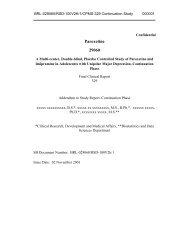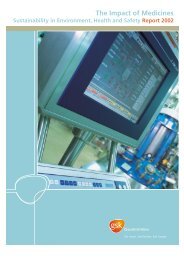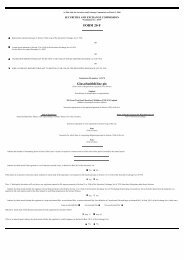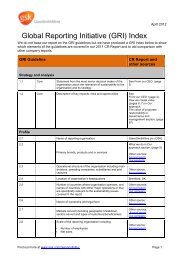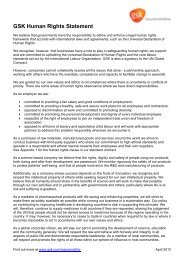GSK Annual Report 2002
GSK Annual Report 2002
GSK Annual Report 2002
You also want an ePaper? Increase the reach of your titles
YUMPU automatically turns print PDFs into web optimized ePapers that Google loves.
110 GlaxoSmithKline Notes to the financial statements<br />
32 Financial instruments and related disclosures<br />
Policies<br />
Discussion of the Group’s objectives and policies for the<br />
management of financial instruments and associated risks is<br />
included under ‘Treasury Policies’ in the Operating and financial<br />
review and prospects on page 62.<br />
Investments<br />
The Group holds a number of equity investments, frequently in<br />
entities where the Group has entered into research collaborations.<br />
The Group seeks to realise the value in these investments, which<br />
in part the research collaboration helps to create, and therefore<br />
certain of these investments are regarded as available for sale and<br />
are accounted for as current asset investments. For the purposes<br />
of US GAAP all the current asset investments are classified as<br />
available for sale.<br />
In <strong>2002</strong>, GlaxoSmithKline hedged part of the equity value of its<br />
holdings in its largest equity investment, Quest Diagnostics, Inc.<br />
through a series of variable sale forward contracts. These contracts<br />
(the ‘equity collar’) are structured in five series, each over one<br />
million Quest shares and mature between 2006 and 2008.<br />
The Group has liquid investments, representing funds surplus to<br />
immediate operating requirements, which are accounted for as<br />
current asset investments. For the purposes of US GAAP the<br />
investments are classified as available for sale. The proceeds from<br />
sale of investments classified as available for sale (under US GAAP)<br />
in the year ended 31st December <strong>2002</strong> were £162 million. The<br />
proceeds include the roll-over of liquid funds on short-term deposit.<br />
The gross gains and losses reflected in the consolidated profit and<br />
loss account in respect of investments classified as available for sale<br />
(under US GAAP) were £44 million and £1 million, respectively.<br />
Foreign exchange risk management<br />
The Group has entered into forward foreign exchange contracts<br />
in order to swap liquid assets and borrowings into the currencies<br />
required for Group purposes. At 31st December <strong>2002</strong> the Group<br />
had outstanding contracts to sell or purchase foreign currency<br />
having a total notional principal amount of £1,937 million<br />
(2001 – £7,312 million). The majority of contracts are for periods<br />
of 12 months or less.<br />
At the end of the year the Group had a number of currency swaps<br />
in place in respect of medium-term debt instruments.<br />
Borrowings denominated in, or swapped into, foreign currencies<br />
which match investments in overseas Group assets are treated as<br />
a hedge against the relevant net assets and exchange gains or<br />
losses are recorded in reserves.<br />
Interest rate risk management<br />
To manage the fixed/floating interest rate profile of debt, the Group<br />
had several interest rate swaps outstanding with commercial banks<br />
at 31st December <strong>2002</strong>.<br />
Concentrations of credit risk and credit exposures of<br />
financial instruments<br />
The Group does not believe it is exposed to major concentrations<br />
of credit risk. The Group is exposed to credit-related losses in the<br />
event of non-performance by counterparties to financial<br />
instruments, but does not expect any counterparties to fail to meet<br />
their obligations. The Group applies Board-approved limits to the<br />
amount of credit exposure to any one counterparty and employs<br />
strict minimum credit worthiness criteria as to the choice of<br />
counterparty.<br />
Fair value of financial assets and liabilities<br />
The table on page 111 presents the carrying amounts under UK<br />
GAAP and the fair values of the Group’s financial assets and<br />
liabilities at 31st December <strong>2002</strong> and 31st December 2001.<br />
Debtors and creditors due within one year have been excluded.<br />
The fair values of the financial assets and liabilities are included<br />
at the amount at which the instrument could be exchanged in a<br />
current transaction between willing parties, other than in a forced<br />
or liquidation sale. The following methods and assumptions were<br />
used to estimate the fair values:<br />
• Equity investments – market value based on quoted market<br />
prices in the case of listed investments; market value by<br />
reference to quoted prices for similar companies or recent<br />
financing information in the case of material unlisted<br />
investments<br />
• Cash at bank – approximates to the carrying amount<br />
• Liquid investments – based on quoted market prices for similar<br />
companies or recent financing information in the case of<br />
marketable securities; approximates to the carrying amount<br />
in the case of time deposits because of their short maturity<br />
• Short-term loans and overdrafts – approximates to the carrying<br />
amount because of the short maturity of these instruments<br />
• Medium-term loans – market value based on quoted market<br />
prices in the case of the Eurobonds and other fixed rate<br />
borrowings; approximates to the carrying amount in the case<br />
of floating rate bank loans and other loans<br />
• Forward exchange contracts – based on market prices and<br />
exchange rates at the balance sheet date<br />
• Currency swaps – based on market valuations at the balance<br />
sheet date<br />
• Equity collar - fair value is determined based on an option<br />
pricing model<br />
• Interest rate instruments – based on market valuations at the<br />
balance sheet date<br />
• Debtors and creditors – approximates to the carrying amount<br />
• Provisions – approximates to the carrying amount<br />
• Auction rate preference stock - approximates to the carrying<br />
amount in the case of floating rate instruments<br />
• Flexible auction market preferred stock - based on market<br />
valuations at the balance sheet date.<br />
Fair value of investments in own shares<br />
The Group had at 31st December <strong>2002</strong> investments in own shares<br />
of £2,826 million (2001 – £2,936 million) with a fair value of<br />
£2,161 million (2001 – £3,229 million). The difference between<br />
the carrying amount and the fair value represents an unrealised<br />
loss of £665 million. This valuation shortfall is not considered to<br />
represent a permanent diminution in value in the context of the<br />
length of the future period over which the related share options<br />
may be exercised. Accordingly no provision has been made. These<br />
investments are excluded from financial instrument disclosure. The<br />
fair value is the market value based on quoted market price.<br />
The shares represent purchases by Employee Share Ownership<br />
Trusts to satisfy future exercises of options and awards under<br />
employee incentive schemes. The purchases are matched against<br />
options at pre-determined exercise prices and the gain or loss to<br />
be recognised is measured against exercise price rather than<br />
market value.








